Lesson Seven - Bucking
BUCKING
Bucking is cutting a fallen tree into logs or smaller products. These may include sawlogs, studwood, pulpwood, fuelwood, fence posts, etc. Bucking enables easier handling of raw wood products during piling, extraction, and trucking. By knowing and following wood quality standards for lengths, grades, or species you can maximize utilization.
When a stem is supported evenly on the ground, a single cut may be all that's needed. However, a fallen tree is often under tension, posing a risk to both you and your saw. A frequent problem occurs when the guide bar binds in the cut, resulting in a severely pinched bar or nose sprocket.
BASIC GUIDELINES
Bucking can also expose you to some potentially dangerous situations. You can minimize the risk of bucking accidents by following these basic guidelines:
Check the work area
Clear away any debris that might interfere with bucking. Look for objects (eg. piled wood) that could cause kickback. On uneven ground, always stand on the uphill side.
Assess the tension
Examine the stem to see where it is supported and how it is bent. This will help you avoid potential problems.
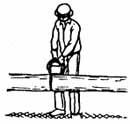 Maintain a firm safe stance
Maintain a firm safe stance
Keep your feet approximately shoulder-width apart and firmly on the ground. For balance, position your left foot slightly ahead of your right foot. This safe stance will allow you to move quickly if the stem suddenly rolls or settles.
Work close to your saw
Keep your arms in a comfortable position - not out-stretched. Maintain a firm grip and always keep your left thumb around the front handle
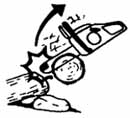 Avoid cutting with the tip
Avoid cutting with the tip
Use the flat sections of the guide bar and practice good bar tip control. A high percentage of chainsaw injuries are caused by kickback.
 With any stem there will always be a "compression" and a "tension" side.
With any stem there will always be a "compression" and a "tension" side.
Examine a bent stem. The inside of the bend is the compression side. Stress will cause this area to compress when cut and bind the saw. Always cut on the compression side first!
 The area on the outside of the bend will pull apart when cut. This is the tension side. If you decide to cut this side only, the tree will split apart before the cut can be completed.
The area on the outside of the bend will pull apart when cut. This is the tension side. If you decide to cut this side only, the tree will split apart before the cut can be completed.
CUTTING TECHNIQUE
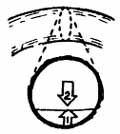 First make a cut on the compression side ' approximately 1/3 of the stem's diameter.
First make a cut on the compression side ' approximately 1/3 of the stem's diameter.
This will usually leave enough wood to keep the stem from pinching the guide bar. Use full throttle. Finish the cut by sawing through from the tension side. You will notice the saw kerf open as you complete this cut.
It is often difficult to determine where the pressure is in a log. Compression (C) and tension (T) areas are identified below in three of the most common situations.
 1. supported at one end
1. supported at one end
2. supported at both ends
3. supported at one point along the stem.
Side Bend
The above procedure is the same for stems bent to one side. However, there is a greater risk of injury. Always stand on the inside of the bend (ie. compression area). When the second cut is made the stem will spring out away from you. Always remain alert.
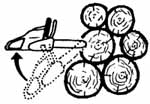 BORING CUT
BORING CUT
The boring cut is a valuable technique for bucking logs piled together that cannot be moved. To avoid kickback, start with the bottom tip of the guide bar.
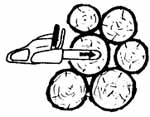 Be sure to hold the saw firmly. Once the cut is sufficiently deep, lift the saw to a horizontal position and bore straight into the stem.
Be sure to hold the saw firmly. Once the cut is sufficiently deep, lift the saw to a horizontal position and bore straight into the stem.
Complete the cut by moving the saw up and down as required.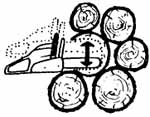
SPRING POLE
A spring pole is a sapling that has been bent over by another tree.
 The resulting shape is an upside down "U". Frequently encountered in forestry operations, the spring pole is under tremendous pressure and if cut incorrectly, whips up with considerable force. Although rarely fatal, it is responsible for a few bruises, scars and broken bones.
The resulting shape is an upside down "U". Frequently encountered in forestry operations, the spring pole is under tremendous pressure and if cut incorrectly, whips up with considerable force. Although rarely fatal, it is responsible for a few bruises, scars and broken bones.
Before attempting to cut the spring pole, first check to see if the felled tree can be removed by a farm tractor or other machine working nearby.
To cut the spring pole, start at the base of the stem and make a series of shallow cuts on the inside of the bend.
Fast, shallow cuts are recommended to avoid jamming the guide bar while releasing some of the tension. With each cut you'll see the force of the spring pole being released. Avoid using the tip of the bar.
 Next, make a final release cut on the opposite side of the stem and below the lowest inside cut. This technique will prevent the sapling from forcefully pushing out your saw.
Next, make a final release cut on the opposite side of the stem and below the lowest inside cut. This technique will prevent the sapling from forcefully pushing out your saw.
 Stand to the side of the tree and never in the line of travel of the cut stem.
Stand to the side of the tree and never in the line of travel of the cut stem.
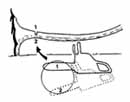 WINDFALLS
WINDFALLS
Windfalls or uprooted trees often pose another serious hazard for forest workers. Misjudging compression and tension areas in the tree will result in your saw becoming jammed. If the stem has an upward bend, make the top cut first. Saw through approximately 1/3 of the diameter. Remember to withdraw the guide before it pinches. Then complete the cut by sawing through from below.
 If the stem has a downward bend, reverse the cutting sequence.
If the stem has a downward bend, reverse the cutting sequence.
Never work beneath an over-hanging root mass. Begin working carefully, limbing and bucking from the top of the windfall. Watch for any sudden movement. Leave a long enough butt log and then have the machine operator lower the root section with the winch. Fell the butt log in the usual manner.
 Occasionally a tree will break, but with the top still attached. Never work beneath the top. When a machine is nearby, let the operator pull it down for you.
Occasionally a tree will break, but with the top still attached. Never work beneath the top. When a machine is nearby, let the operator pull it down for you.
 If a machine is not available, begin by limbing from the top and bucking off lengths. Don't limb above shoulder height. Then, using the felling lever, roll the remaining stem to the ground. Fell the remaining stub in the usually manner.
If a machine is not available, begin by limbing from the top and bucking off lengths. Don't limb above shoulder height. Then, using the felling lever, roll the remaining stem to the ground. Fell the remaining stub in the usually manner.
 Always select a suitable escape route and make sure it's clear of obstacles.
Always select a suitable escape route and make sure it's clear of obstacles.
MEASURING FOREST PRODUCTS
While bucking trees, it is important to cut the products into proper lengths.
Generally, bucking specifications are provided by the person or company purchasing the product. It is the responsibility of the cutter to know these specifications and apply them correctly.
Several things can be used to assist with the accuracy of bucking. They include:
- loggers tape or measuring tape
- a plastic measuring tail (whip, wand) attached to the saw
- the chainsaw
- measuring pole
Once measured, the bucking cut can be performed as discussed.